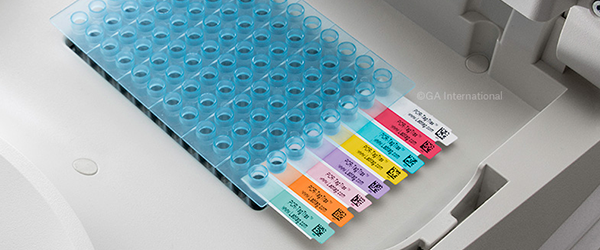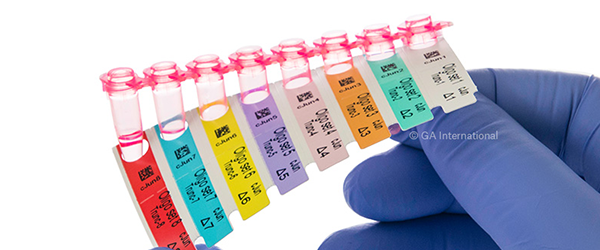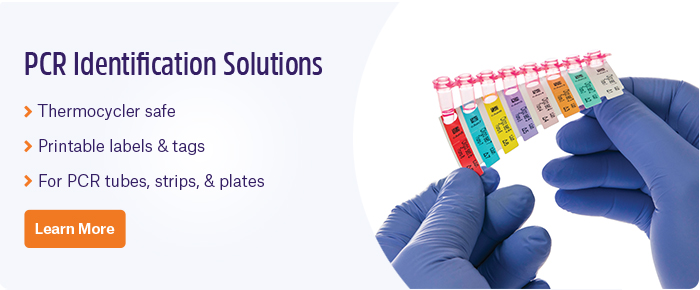 Polymerase chain reaction (PCR) is one of the most widely used techniques among biomedical researchers, forensic scientists, and medical laboratory professionals. It’s employed for genotyping, sequencing, cloning, and gene expression analysis to name only a handful of its applications. However it’s a challenge to label PCR tubes and, as they are relatively small, providing little space for information, while skirted quantitative PCR (qPCR) plates can only be labeled on their side.
Polymerase chain reaction (PCR) is one of the most widely used techniques among biomedical researchers, forensic scientists, and medical laboratory professionals. It’s employed for genotyping, sequencing, cloning, and gene expression analysis to name only a handful of its applications. However it’s a challenge to label PCR tubes and, as they are relatively small, providing little space for information, while skirted quantitative PCR (qPCR) plates can only be labeled on their side.
The Complete Solution
The latest and best option for labeling high-profile PCR tubes, strips, and qPCR plates is the patent-pending PCR-TagTrax. The versatile design of the non-adhesive tag allows it to be used to identify 0.2 ml high-profile PCR tubes, high-profile 8-tube PCR strips, and non-skirted qPCR plates in a variety of configurations. The main advantage PCR-TagTrax affords is an optimal amount of space for printing or, if necessary, handwriting. The tags can be printed with serialized numbering as well as 1D or 2D barcodes using a thermal-transfer printer and resist temperatures as low as -196°C and as high as +150°C, making them compatible with most thermocyclers (it’s always a good idea to test a sample of the tags with your own thermocycler to make sure they don’t interfere in the reaction). They are also glove-friendly, give you a quick bird’s eye view of the information printed on the tags once the thermocycler is opened, and are available in a range of colors, or in a multicolor format, for easy and convenient color coding. The adhesive-free tags can even be used as a stand for your tubes, making it easy to pipette reagents into them once they’re labeled and to store them in the fridge or freezer following the reaction.

0.2 ml PCR Tubes
There are two possible locations to label individual PCR tubes: the side of the tube and its cap. Side labels for small PCR tubes are available for both laser and thermal-transfer printers and come in a variety of colors for easy color coding. These PCR tube labels allow more information to be printed than can be written by hand and can also incorporate barcodes to enhance trackability. The labels are thermocycler-compatible and will withstand long-term storage in lab freezers.
When labeling PCR tube caps, round dot labels are the ideal choice. Applying dot labels is one of the more common ways of labeling general-use tubes. However, dot labels provide relatively little space on the tube to either print or write information, making it one of the least efficient methods of PCR tube labeling. If you must use dot labels for PCR tubes and will need to label a large volume of them, you can increase your efficiency by using the PikaTAG™, a label application accessory that picks up dot labels directly from their liner and attaches them to the tops of tubes. It has an ergonomic pen-like design that makes dot labeling fast and easy, eliminating the tedious task of picking small labels and preventing repetitive stress injuries due to incessant tube labeling.
PCR Tube Strips
For labs that perform a fair amount of PCR and qPCR reactions, PCR strips are commonly used. Labeling these strips can prove even more difficult than individual tubes, as each tube is connected to the next, further reducing what limited identification space there was to begin with. Luckily, 8-tube label strips conform to each tube, making labeling PCR strips much easier. These strips, initially invented by GA International, come with perforations between each label in the roll, so you can print as many labels as there are tubes, place the entire label strip adjacent to the side of the tubes, affix all labels simultaneously, then break the perforations to secure the labels firmly on the side. These thermal-transfer printable labels have a temperature range of -80°C to +100°C, so they are safe for use in thermocyclers and can be stored securely in laboratory freezers.
Skirted and Semi-Skirted qPCR Plates
The best option for skirted qPCR plates is using rectangular plate labels that can be affixed to the sides of each plate. These labels are made to be glove-friendly so that you can easily reposition the label without leaving residue on your gloves or the plate. The plate labels are also thermocycler safe and will not interfere with automated liquid handlers used in high-throughput genotyping and sequencing. They can be used to identify 96-, 384-, and even 1,536-well standard plates.
The Old Method
Handwriting is the conventional means to identify PCR tubes, but hardly the best, as it’s nearly impossible to write legibly on PCR tubes. Because the tubes are so small, it’s also very difficult to avoid smudging the writing with your gloved fingers. Handwriting also means foregoing serialization and barcodes, diminishing your ability to track and trace your samples. If handwriting is the only viable option for your lab, it’s worth investing in fine-tip cryo markers, which can resist deep-freeze storage and provide a relatively small tip, so you can write as legibly as possible without the writing fading or smudging.
LabTAG by GA International is a leading manufacturer of high-performance specialty labels and a supplier of identification solutions used in research and medical labs as well as healthcare institutions.




